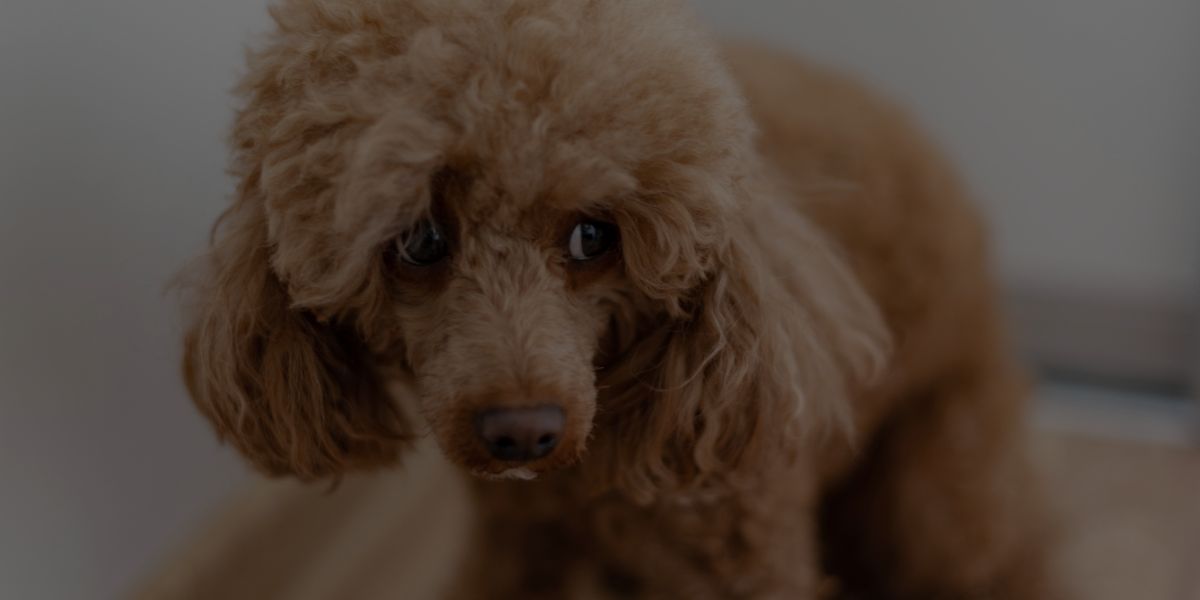As a kid, you were probably at least a little scared of going to the dentist. (To be fair, I’m a fully grown adult and I’m still a bit scared of going to the dentist.) Well, it turns out that some dogs feel the same way about grooming. Grooming can be a really stressful experience for anxious dogs, which is why it’s important to know how to groom an anxious dog properly.
So, maybe you’re a dog groomer (aspiring or professional). Or perhaps you simply need some help grooming your own dog at home. Either way, you’ve come to the right place! Today, we’re going to discuss how to groom an anxious dog properly, humanely, and successfully!
Keep reading to learn everything you need to know!
First things first: it’s important to understand that dogs with anxiety at the groomer’s aren’t necessarily naughty dogs. In fact, most of the time, it’s completely out of their control!
There are a number of reasons why dogs might feel anxious at the groomer’s. For example, some dogs simply don’t like being away from their guardians. Others may be afraid of the unfamiliar sights, smells, and sounds of the grooming salon. And some dogs may have had a bad experience in the past that has left them feeling scared or anxious.
Whatever the reason, it’s important to remember that your dog isn’t misbehaving on purpose – they’re just feeling a bit overwhelmed!
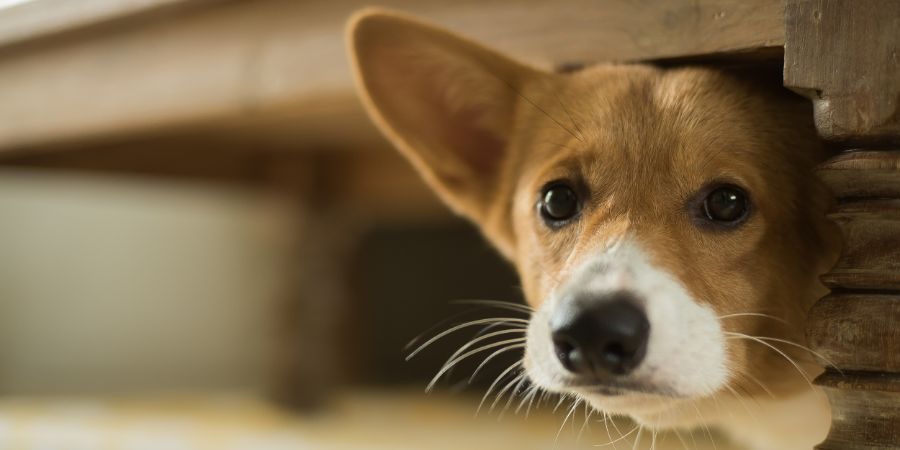
How To Groom An Anxious Dog: 20 Top Tips To Remember
Now that we’ve got that out of the way, let’s talk about how to groom an anxious dog. Here are 20 top tips to remember:
1. Start slow and build up gradually.
If your dog – or your client’s dog – is feeling anxious about grooming, it’s important to take things slow and easy. Start with short grooming sessions and gradually increase the length of each session as the dog gets more comfortable.
2. Choose a quiet time of day.
When scheduling grooming appointments, try to choose a time of day when the salon is less busy. For instance, my Corgi, Ginny, is a rescue and struggles with major anxiety anytime she’s anywhere but our home. Moreover, she’s terrified of people and other dogs alike. So, whenever I schedule a grooming appointment, I ask
If you’re a professional groomer, and you know your client has a dog with anxiety, try to schedule their appointment for a time when you’re not rushed and can take things slow.
3. Let the dog approach you.
When you first see an anxious dog, resist the urge to approach them. Instead, let the dog come to you on their own terms. This will help them feel more in control and less anxious.
4. Speak calmly and quietly.
When you do start to interact with the dog, it’s important to speak calmly and quietly. Avoid using a high-pitched, excited voice – this will only make the dog more anxious. Furthermore, silence can be golden with some anxious dogs. Meaning, speak to them when necessary… But keeping quiet otherwise might be exactly what they need!
5. Get your dog used to being handled.
If you’re the owner of an anxious dog, it’s important to get them used to being handled – especially if they’re not used to it. Start by gently petting them and slowly increase the amount of time you spend handling them. You can also try things like massaging their paws or giving them a gentle brush. The more comfortable they are with being handled, the easier grooming will be!
On the other hand, if you’re the dog groomer, and your client has, say, a puppy, you can suggest to them that they start handling their pup more often. In turn, this will make the grooming process much easier for both you and the dog!
6. Make sure the dog is comfortable with being touched all over their body – not just in specific areas.
This is similar to the previous point, but it’s important to make sure the dog is comfortable with being touched all over their body – not just in specific areas. For example, some dogs may be okay with having their head and neck petted, but they may not be okay with someone touching their feet or tail.
However, it’s important to get the dog used to being touched all over. This way, they’re more comfortable during the grooming process.
7. Gently desensitize the dog to the grooming process.
If you’re the owner of an anxious dog, it’s important to gently desensitize them to the grooming process. Start by simply showing them the grooming tools (e.g., brush, comb, scissors, clippers, etc.). Let them sniff and investigate each tool at their own pace. Once they seem comfortable, you can start using the tools on them – but make sure to go slowly!
As the dog gets more comfortable with the grooming tools, you can gradually increase the amount of time you spend grooming them.
On the other hand, if you’re the dog groomer, you can suggest to the owner that they start slowly desensitizing their dog to the grooming process at home. This way, the dog is more comfortable – and less anxious – by the time they come to see you!
Pro Tip: Not yet a certified, professional dog groomer? Learn how to become one – even if you don’t have any experience!
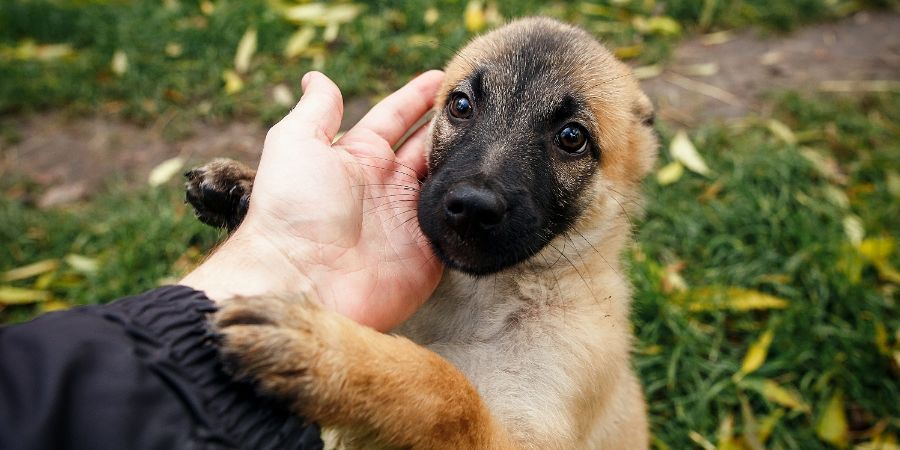
8. Be gentle and patient.
This one goes without saying, but it’s important to be gentle and patient when grooming an anxious dog. Dogs can sense when we’re anxious or stressed, so it’s important to remain calm throughout the process.
9. Offer lots of praise and treats.
As you progress through the grooming process (and especially once it’s all over), make use of positive reinforcement methods. This can include offering lots of praise, treats, and/or belly rubs. The reason behind this is that you’ll be creating a positive association with the grooming process – which will help make the dog less anxious next time around!
10. Take your time.
Don’t rush the grooming process! If you try to hurry things along, it will only make the dog more anxious. Instead, take your time and let the dog dictate the pace.
11. Be prepared for setbacks.
Even if you follow all of these tips, there’s still a chance that your dog could have a bad experience while being groomed. It’s important to be prepared for this possibility and have a plan in place in case it happens.
For example, you might want to have a “safe word” that you can use to signal to the dog that they need to take a break. Alternatively, you might want to have a towel or blanket on hand that you can use to cover the dog if they start to get too anxious.
12. Seek professional help if necessary.
If you’ve tried everything and your dog is still anxious while being groomed, it might be time to seek professional help. There are many dog behaviorists and trainers who specialize in helping dogs with anxiety.
So, if you’re a dog parent and have concerns, don’t hesitate to reach out for help! And if you’re a professional groomer, it could be worth mentioning to your client that they seek professional help for their dog’s anxiety.
13. Consider using a muzzle.
If you’re really struggling to groom your dog humanely, or the dog’s anxiety is leading to aggression, you might want to consider using a muzzle. This is definitely a last resort, but it can be helpful in some situations.
There are many different types of muzzles available on the market. So, it’s important to do your research and find one that’s comfortable for the dog and won’t hinder their breathing.
14. Try dog-friendly grooming products.
There are many different dog grooming products on the market, and some are better than others. When choosing products for your anxious dog, it’s important to find ones that are gentle and won’t irritate their skin. You might also want to look for products that have a calming effect, such as lavender-scented shampoo.
15. Make sure they can’t jump off the grooming table.
If your client’s dog is anxious and trying to jump off the grooming table, it’s important to make sure they can’t actually do it. This might mean securing a leash around their waist, using a nonslip mat on the table, or tying them down with a bandana.
That last one is definitely a last resort, but it could be necessary in some cases. After all, the last thing you want them to do is try to jump off the table while wearing a neck leash!
16. Use a calming supplement.
There are many different supplements on the market that claim to have a calming effect on dogs. While there’s no guarantee that they’ll work for every dog, it might be worth trying one if you’re struggling to calm your anxious dog.
The most important thing is to do your research and talk to your vet before giving your dog any kind of supplement. This is because some of them can interact with other medications that your dog might be taking.
And if you’re the groomer?
NEVER give your client’s dog a supplement without their permission! Furthermore, you should never give the dog anything without your client’s vet first giving the OK. Generally speaking, a good rule of thumb is to just not give your client’s dog anything of that nature unless they’re the one who asked you to.
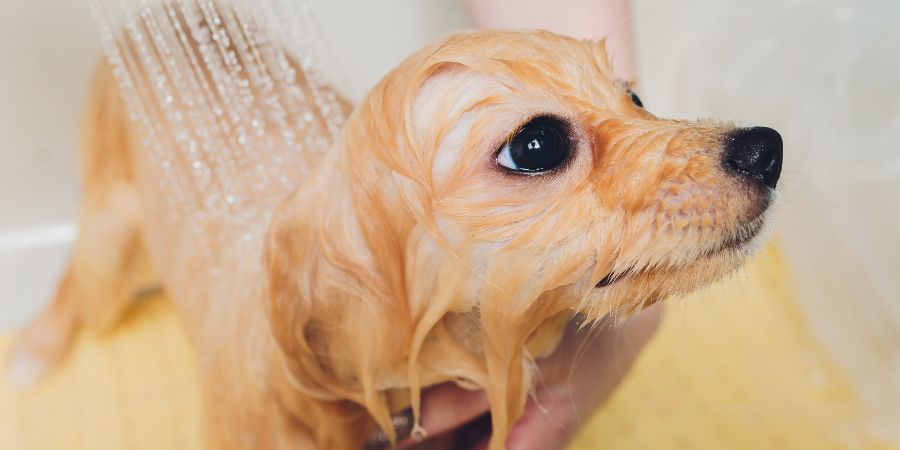
17. Be extra careful with anxious dogs during nail trims.
Anxious dogs are more likely to struggle and move around while you’re trimming their nails. This can make it difficult to do a good job and can also be dangerous for both you and the dog.
So, it’s important to be extra careful when trimming the nails of an anxious dog. Make sure you’re holding them securely and only trim a little bit at a time.
If you’re not comfortable trimming the nails of an anxious dog, it’s okay to ask your client to find someone else to do it. Their safety is more important than anything else!
18. Give them as many breaks as they need.
When grooming an anxious dog, it’s important to give them as many breaks as they need. This might mean taking a few minutes between each step of the grooming process or even stopping altogether if the dog is getting too stressed.
It’s also important to have a lot of patience when grooming an anxious dog. They might not be able to sit through a whole grooming session without taking a break – and that’s okay.
19. Try a different type of grooming.
If your dog is anxious about traditional grooming, it might be worth trying a different type of grooming. For example, there are many mobile dog groomers that will come to your house to groom your dog in a more relaxed environment.
There are also certain types of grooming that are less invasive than others. For example, you might want to try brushing their teeth or trimming their nails instead of giving them a bath or a haircut.
20. Find a dog groomer you trust.
Last but not least, as a dog parent, it’s important to find a groomer you trust. This is someone who you feel comfortable leaving your dog with, and who you know will take good care of them.
If you don’t already have a groomer in mind, ask your friends, family, and fellow dog owners for recommendations. Once you’ve found a few potential candidates, take the time to tour their facility and meet with the groomer to see if they’re a good fit for your dog.
Pro Tip: These 5 steps will help you GUARANTEE that you pick the right dog groomer for you and your pooch!
And if you’re the groomer?
Make sure your clients feel comfortable leaving their dog with you! This means being open and honest about your experience, answering any questions they have, and providing a tour of your facility. It’s also important to be flexible and accommodating to their needs – after all, every dog is different!
Here are some quick tips to help you ensure that you make your client comfortable and gain their trust:
- Be open and honest about your experience
- Answer any questions they have
- Provide a tour of your facility
- Be flexible and accommodating to their needs – and the needs of their dog
Grooming a Dog With Anxiety: FAQs
Q: How do you calm an anxious dog for grooming?
A: There are a few things you can do to calm an anxious dog for grooming, including:
- Putting them in a quiet, calm environment
- Giving them breaks as needed
- Trying a different type of grooming
- Finding a dog groomer you trust
Q: How often should you groom an anxious dog?
A: How often you groom an anxious dog will depend on their individual needs. Some dogs may need to be groomed more frequently if they have a lot of anxiety, while others may only need to be groomed every few weeks or months.
Q: How much does it cost to groom an anxious dog?
A: How much it costs to groom an anxious dog will depend on the groomer, the type of grooming, and the dog’s individual needs. However, you can expect to pay more for a groomer who has experience with anxious dogs and/or offers a more relaxed environment.
Q: As a dog groomer, should you charge more to groom dogs with anxiety?
A: That’s really up to you, and will depend on your individual business. Some groomers may charge more for dogs with anxiety, while others may not. Ultimately, it’s up to you to decide what you feel is fair.
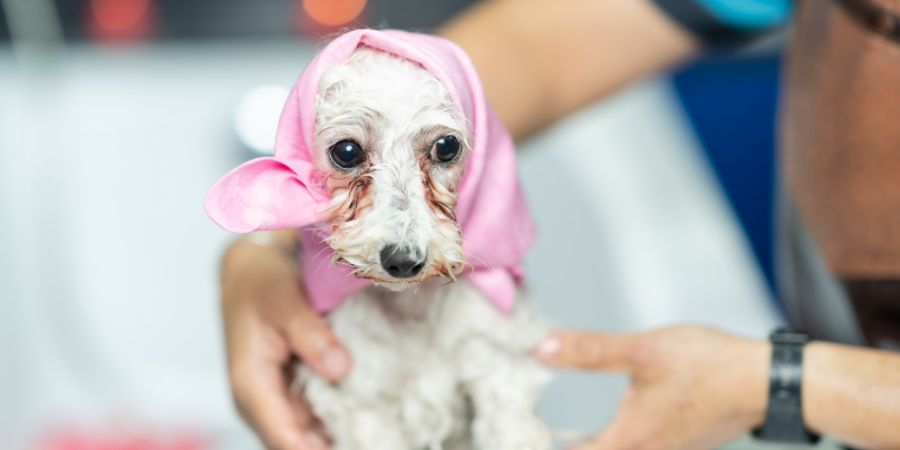
Q: What are some signs that a dog is anxious during grooming?
A: Some signs that a dog is anxious during grooming include panting, shaking, whimpering, stress shedding, and trying to escape. Additionally, some dogs may show their stress through fear aggression, which can include biting or growling. If you notice any of these signs, it’s important to take a break and try again later.
Q: What should you do if an anxious dog won’t stop being aggressive?
A: If an anxious dog won’t stop being aggressive, it’s best to seek professional help from a certified dog trainer or animal behaviorist. If you’re a groomer, this would be a helpful suggestion you can make to your client.
If the dog is truly aggressive and poses a threat to you or others during their grooming appointment, it’s best to end the session and have the owner pick up their dog as soon as possible.
Interested in a career as a professional, certified dog trainer? QC Pet Studies‘ self-paced, online Dog Training Course will turn YOU into an International Dog Training Professional™ (IDTP™) in as little as 3-6 months!
Q: Are certain dog breeds more prone to anxiety than others?
A: Yes. Some dog breeds are more prone to anxiety than others, including:
- Dalmatians
- Bichon Frises
- Cocker Spaniels
- Shih Tzus
- Poodles
- Labrador Retrievers
- Golden Retrievers
Is there a reason behind this? Honestly, there’s no one answer to this question. Every dog is different! However, some experts believe that it may be due to the fact that these breeds are more sensitive to changes in their environment and routine.
Q: Can age affect a dog’s level of anxiety?
A: Yes, age can absolutely affect a dog’s level of anxiety. Puppies and senior dogs are more likely to experience anxiety due to changes in their environment and routine. Additionally, dogs who have never been groomed before, as well as dogs with little to no socialization training, may also be more anxious about the experience.
Q: Do groomers sedate dogs to groom them?
A: No, groomers do not sedate dogs to groom them. Sedation is incredibly dangerous and can actually increase a dog’s anxiety levels. Furthermore, this is outside the scope of a dog groomer’s trained capabilities. In fact, if a groomer does suggest sedation, it’s best to find another groomer entirely.
Q: Will a professional dog grooming course teach you how to work with anxious dogs?
A: ABSOLUTELY! A professional dog grooming course, like QC Pet Studies’ self-paced, online Dog Grooming certification course, will teach you many things… And one of those things is how to work with anxious dogs. Moreover, this course will provide you with the skills and knowledge you need to confidently and successfully groom any dog, no matter their temperament.
Learn more about QC’s online Dog Grooming Course and our globally-recognized International Dog Grooming Professional™ (IDGP™) certification!
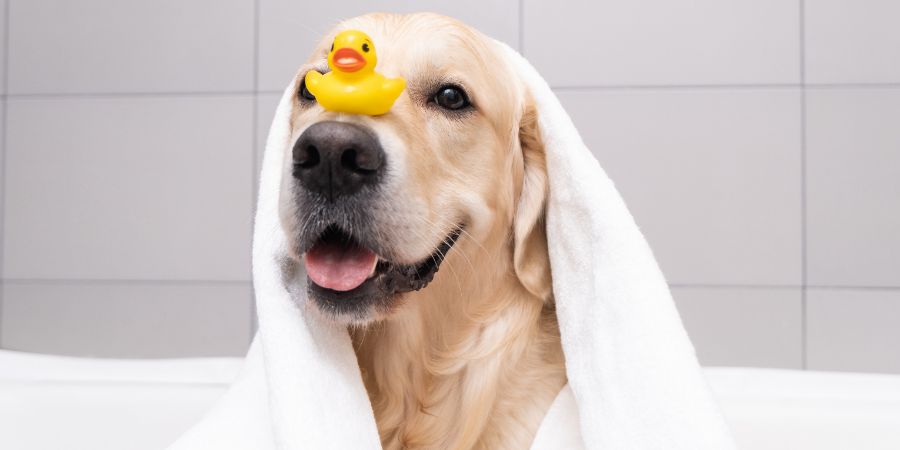
Dog Grooming for Anxious Dogs: Final Thoughts
Anxious dogs can be a challenge to groom, but it’s not impossible! With patience, understanding, and the right approach, you can successfully groom any dog. Just remember to take your time, be gentle, and never force your dog to do anything they’re uncomfortable with.
If you keep the 20 tips listed in this article in mind, you’re sure to have a much easier time grooming your anxious dog. And, who knows? They may even start to enjoy it!
As always, if you have any further questions or concerns about dog grooming for anxious dogs, please don’t hesitate to reach out to us. We’re always happy to help!
Thanks for reading – and happy grooming! 🐶
ovide you with the skills and knowledge you need to confidently and successfully groom any dog, no matter their temperament.
